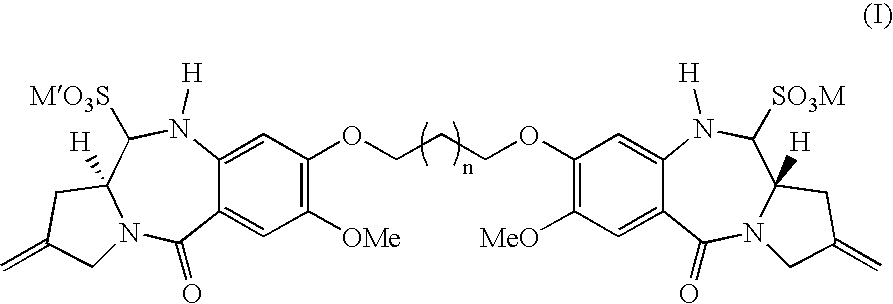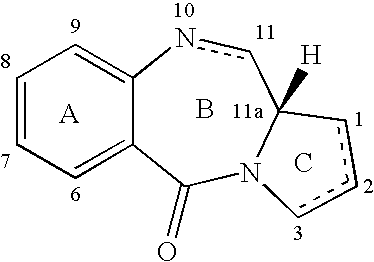Pyrrolobenzodiazepines
a technology of pyrrolobenzodiazepines and di-carbinolamines, which is applied in the field of pyrrolobenzodiazepines, can solve the problems of converting to di-carbinolamine forms, affecting the effect of drug effect, and difficulty in accurately assessing the amount of active substances in a given amoun
- Summary
- Abstract
- Description
- Claims
- Application Information
AI Technical Summary
Benefits of technology
Problems solved by technology
Method used
Image
Examples
example 1
Synthesis of 1,1′[[(Propane-1,3-diyl)dioxy]bis(11aS)-11-sulpho-7-methoxy-2-methylidene-1,2,3,10,11,11a-hexahydro-5H-pyrrolo[2,1-c][1,4-benzodiazepin-5-one]] sodium salt (SJG-720)
[0056]
[0057]A solution of sodium bisulphite (13.2 mg, 0.127 mmol) in water (5.2 mL) was added to a stirred solution of SJG-136 (35.19 mg, 63.3 μmol) in dichloromethane (2.5 mL, Aldrich sure seal grade). The reaction mixture was allowed to stir vigorously for 24 hours, after which time the organic and aqueous layers were separated. TLC analysis (eluent-95:5 v / v CHCl3 / MeOH) of the aqueous phase revealed absence of SJG-136 (Rf˜0.3) and presence of baseline material with strong uv absorption. The aqueous layer was lyophilised to provide the bisulphite adduct SJG-720 as a lightweight white solid (40.88 mg, 85%). Mpt. 213–216° C. [α]29D+126.2° (c=0.0317 MeOH)
example 2
Synthesis of 1,1′[[(Pentane-1,3-diyl)dioxy]bis(11aS)-11-sulpho-7-methoxy-2-methylidene-1,2,3,10,11,11a-hexahydro-5H-pyrrolo[2,1-c][1,4-benzodiazepin-5-one]] sodium salt (SJG-738)
[0058]
[0059]A solution of sodium bisulphite (16.46 mg, 0.158 mmol) in water (3.0 mL) was added to a stirred solution of DRG-16 (46.2 mg, 79.1 μmol) in dichloromethane (1.5 mL, Aldrich sure seal grade). The reaction mixture was allowed to stir vigorously for 22 hours, after which time the organic and aqueous layers were separated. TLC analysis (eluent-95:5 v / v CHCl3 / MeOH) of the aqueous phase revealed absence of DRG-16 (Rf˜0.3) and presence of baseline material with strong uv absorption. The aqueous layer was lyophilised to provide the bisulphite adduct SJG-738 as a lightweight white solid (47.95 mg, 77%). Mpt. 203–204° C. [α]27D+117.6° (c=0.0425 MeOH).
Further Studies
[0060]All NMR experiments were performed using a Bruker Avance 400 MHz NMR spectrophotometer. NMR solvents were purchased from Goss Scientific.
T...
PUM
| Property | Measurement | Unit |
|---|---|---|
| time | aaaaa | aaaaa |
| time | aaaaa | aaaaa |
| volume | aaaaa | aaaaa |
Abstract
Description
Claims
Application Information
 Login to View More
Login to View More - R&D
- Intellectual Property
- Life Sciences
- Materials
- Tech Scout
- Unparalleled Data Quality
- Higher Quality Content
- 60% Fewer Hallucinations
Browse by: Latest US Patents, China's latest patents, Technical Efficacy Thesaurus, Application Domain, Technology Topic, Popular Technical Reports.
© 2025 PatSnap. All rights reserved.Legal|Privacy policy|Modern Slavery Act Transparency Statement|Sitemap|About US| Contact US: help@patsnap.com



